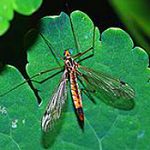Crane flies are insects in the family Tipulidae. Adults are very slender, long-legged flies that may vary in length from 2-60 millimetres (0.079-2.4 in) (tropical species may exceed 100 millimetres or 3.9 in).
The larvae of the European Crane Fly are commonly known as Leatherjackets. These larvae can cause damage to lawns by feeding on the roots of grass plants.
Numerous other common names have been applied to the crane fly, many of them more or less regional, including mosquito hawk, mosquito eater (or skeeter eater), gallinipper,[1] and gollywhopper.
In appearance crane flies seem long and gangly, with very long legs, and a long slender abdomen. The wings are often held out when at rest, making the large halteres easily visible. Unlike most flies, crane flies are weak and poor fliers with a tendency to “wobble” in unpredictable patterns during flight, and they can be caught without much effort.
Crane flies vary in size, with temperate species ranging from 2 to 60 millimetres (0.079 to 2.4 in), while tropical species have been recorded at over 100 millimetres (3.9 in). The giant crane fly (Holorusia rubiginosa) of the western United States can reach 38 millimetres (1.5 in). Some Tipula species are 64 millimetres (2.5 in). Many smaller species (known as bobbing gnats) are mosquito-sized, but they can be distinguished from mosquitoes by the V-shaped suture on the thorax, nonpiercing mouthparts, and a lack of scales on the wing veins.
Despite their common names, as adults, crane flies do not prey on mosquitoes, nor do they bite humans. Some larval crane flies are predatory and may eat mosquito larvae. Adult crane flies feed on nectar or they do not feed at all; once they become adults, most crane fly species exist as adults only to mate and die. Their larvae, called “leatherjackets”, “leatherbacks”, “leatherback bugs” or “leatherjacket slugs”, because of the way they move, consume roots (such as those of turf grass) and other vegetation, in some cases causing damage to plants. The crane fly is occasionally considered a mild turf pest in some areas. In 1935, Lord’s Cricket Ground in London was among the venues affected by leatherjackets: several thousand were collected by ground staff and burned, because they caused bald patches on the wicket and the pitch took unaccustomed spin for much of the season.
Little is known of the juvenile biology of many crane fly species. The larvae of less than 2% of the species have been described. Of those that have been described, many prefer moist environments, and some leatherjackets are aquatic.

